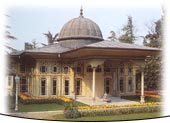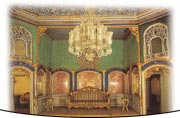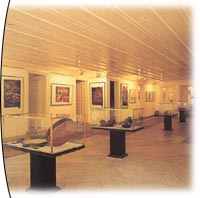The Aynalıkavak Mansions
AYNALIKAVAK
PAVILION
 Aynalıkavak
Pavilion is the sole remaining building from a large Ottoman palace known as
Aynalıkavak Palace or Tersane palace, dating back to the 17th century.
This pretty building on the shore or the Golden Horn is a reminder that this
now built-up area was for centuries a place parks, meadows and streams where
the Ottoman sultans and before them the Byzantines came for country excursions.
Aynalıkavak
Pavilion is the sole remaining building from a large Ottoman palace known as
Aynalıkavak Palace or Tersane palace, dating back to the 17th century.
This pretty building on the shore or the Golden Horn is a reminder that this
now built-up area was for centuries a place parks, meadows and streams where
the Ottoman sultans and before them the Byzantines came for country excursions.
After the Turkish
conquest of İstanbul this attractive stretch of countryside stretching inland
from the Golden Horn became an imperial park known as the Tersane Hasbahçe after
the naval arsenal at neabry Kasımpaşa.
 The
earliest known building here dates from the reign of Sultan Ahmed I (1603-1617),
and his successors added new country lodges over the centuries, until the entire
complex became so large that is was referred to as Tersane or Aynalıkavak Palace.
The
earliest known building here dates from the reign of Sultan Ahmed I (1603-1617),
and his successors added new country lodges over the centuries, until the entire
complex became so large that is was referred to as Tersane or Aynalıkavak Palace.
Aynalıkavak Pavilion
is one of these buildings, thought to date originally from the reign of Sultan
Ahmed III (1703-1730), although extensive alterations under Selim III (1789-1807)
transformed its appearance radically.The principal rooms are a reception room
known as the Divanhane and the smaller Music Room. Bands of exquisite calligraphic
decoration around the windows of these two rooms consist of verses by two famous
poets, Şeyh Galib and Enderûni Fâzıl, in praise of the pavilion and Selim III.
These talik inscriptions were designed by the calligrapher Yesari.
 In
terms of its architecture and decoration Aynalıkavak Pavilion is a rare and
outstanding example of classical Ottoman architecture. This small building is
only one storey, with a basement under the section facing the sea. The pavilion
is of additional interest because of its strong associations with Sultan Selim
III, a respected composer. The traditional fitted seats or sedir along the walls
and settees resembling sedir, braziers, lamps and other contemporary furnishings
reflect a way of life which has disappeared entirely today.
In
terms of its architecture and decoration Aynalıkavak Pavilion is a rare and
outstanding example of classical Ottoman architecture. This small building is
only one storey, with a basement under the section facing the sea. The pavilion
is of additional interest because of its strong associations with Sultan Selim
III, a respected composer. The traditional fitted seats or sedir along the walls
and settees resembling sedir, braziers, lamps and other contemporary furnishings
reflect a way of life which has disappeared entirely today.
Today as an appropriate
tribute to Sultan Selim III, who is a major figure of Turkish classical music,
the basement of Aynalıkavak Pavilion houses an exhibition of Turkish musical
instruments donated by various individuals and institutions, together with photographs
of antique instruments at Topkapı Palace Museum. In summer the pretty gardens
and cafeteria attract many visitors, as do the Aynalıkavak Concerts of classical
Turkish art music. Private receptions are held in the gardens here.